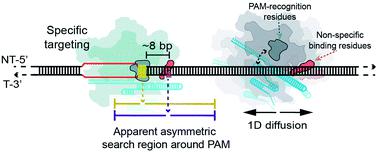当前位置:
X-MOL 学术
›
Chem. Sci.
›
论文详情
Our official English website, www.x-mol.net, welcomes your
feedback! (Note: you will need to create a separate account there.)
Nonspecific interactions between SpCas9 and dsDNA sites located downstream of the PAM mediate facilitated diffusion to accelerate target search
Chemical Science ( IF 7.6 ) Pub Date : 2021-08-20 , DOI: 10.1039/d1sc02633j Mengyi Yang 1, 2 , Ruirui Sun 1 , Pujuan Deng 3 , Yuzhuo Yang 1 , Wenjuan Wang 4 , Jun-Jie Gogo Liu 3 , Chunlai Chen 1
Chemical Science ( IF 7.6 ) Pub Date : 2021-08-20 , DOI: 10.1039/d1sc02633j Mengyi Yang 1, 2 , Ruirui Sun 1 , Pujuan Deng 3 , Yuzhuo Yang 1 , Wenjuan Wang 4 , Jun-Jie Gogo Liu 3 , Chunlai Chen 1
Affiliation

|
RNA-guided Streptococcus pyogenes Cas9 (SpCas9) is a sequence-specific DNA endonuclease that works as one of the most powerful genetic editing tools. However, how Cas9 locates its target among huge amounts of dsDNAs remains elusive. Here, combining biochemical and single-molecule fluorescence assays, we revealed that Cas9 uses both three-dimensional and one-dimensional diffusion to find its target with high efficiency. We further observed surprising apparent asymmetric target search regions flanking PAM sites on dsDNA under physiological salt conditions, which accelerates the target search efficiency of Cas9 by ∼10-fold. Illustrated by a cryo-EM structure of the Cas9/sgRNA/dsDNA dimer, non-specific interactions between DNA ∼8 bp downstream of the PAM site and lysines within residues 1151–1156 of Cas9, especially lys1153, are the key elements to mediate the one-dimensional diffusion of Cas9 and cause asymmetric target search regions flanking the PAM. Disrupting these non-specific interactions, such as mutating these lysines to alanines, diminishes the contribution of one-dimensional diffusion and reduces the target search rate by several times. In addition, low ionic concentrations or mutations on PAM recognition residues that modulate interactions between Cas9 and dsDNA alter apparent asymmetric target search behaviors. Together, our results reveal a unique searching mechanism of Cas9 under physiological salt conditions, and provide important guidance for both in vitro and in vivo applications of Cas9.
中文翻译:

SpCas9 和位于 PAM 下游的 dsDNA 位点之间的非特异性相互作用介导促进扩散以加速目标搜索
RNA引导的化脓性链球菌Cas9 (SpCas9) 是一种序列特异性 DNA 核酸内切酶,是最强大的基因编辑工具之一。然而,Cas9 如何在大量 dsDNA 中定位其目标仍然难以捉摸。在这里,结合生化和单分子荧光分析,我们发现 Cas9 使用三维和一维扩散来高效地找到其目标。我们进一步观察到在生理盐条件下 dsDNA 上 PAM 位点侧翼的明显不对称目标搜索区域令人惊讶,这将 Cas9 的目标搜索效率提高了约 10 倍。通过 Cas9/sgRNA/dsDNA 二聚体的冷冻电镜结构说明,PAM 位点下游 8 bp DNA 与 Cas9 残基 1151-1156 内的赖氨酸之间的非特异性相互作用,尤其是 lys1153,是介导 Cas9 一维扩散并导致 PAM 侧翼目标搜索区域不对称的关键因素。破坏这些非特异性相互作用,例如将这些赖氨酸突变为丙氨酸,会减少一维扩散的贡献,并将目标搜索率降低几倍。此外,调节 Cas9 和 dsDNA 之间相互作用的 PAM 识别残基上的低离子浓度或突变会改变明显的不对称目标搜索行为。总之,我们的结果揭示了 Cas9 在生理盐条件下的独特搜索机制,并为两者提供了重要指导 减少一维扩散的贡献,将目标搜索率降低数倍。此外,调节 Cas9 和 dsDNA 之间相互作用的 PAM 识别残基上的低离子浓度或突变会改变明显的不对称目标搜索行为。总之,我们的结果揭示了 Cas9 在生理盐条件下的独特搜索机制,并为两者提供了重要指导 减少一维扩散的贡献,将目标搜索率降低数倍。此外,调节 Cas9 和 dsDNA 之间相互作用的 PAM 识别残基上的低离子浓度或突变会改变明显的不对称目标搜索行为。总之,我们的结果揭示了 Cas9 在生理盐条件下的独特搜索机制,并为两者提供了重要指导Cas9 的体外和体内应用。
更新日期:2021-09-07
中文翻译:

SpCas9 和位于 PAM 下游的 dsDNA 位点之间的非特异性相互作用介导促进扩散以加速目标搜索
RNA引导的化脓性链球菌Cas9 (SpCas9) 是一种序列特异性 DNA 核酸内切酶,是最强大的基因编辑工具之一。然而,Cas9 如何在大量 dsDNA 中定位其目标仍然难以捉摸。在这里,结合生化和单分子荧光分析,我们发现 Cas9 使用三维和一维扩散来高效地找到其目标。我们进一步观察到在生理盐条件下 dsDNA 上 PAM 位点侧翼的明显不对称目标搜索区域令人惊讶,这将 Cas9 的目标搜索效率提高了约 10 倍。通过 Cas9/sgRNA/dsDNA 二聚体的冷冻电镜结构说明,PAM 位点下游 8 bp DNA 与 Cas9 残基 1151-1156 内的赖氨酸之间的非特异性相互作用,尤其是 lys1153,是介导 Cas9 一维扩散并导致 PAM 侧翼目标搜索区域不对称的关键因素。破坏这些非特异性相互作用,例如将这些赖氨酸突变为丙氨酸,会减少一维扩散的贡献,并将目标搜索率降低几倍。此外,调节 Cas9 和 dsDNA 之间相互作用的 PAM 识别残基上的低离子浓度或突变会改变明显的不对称目标搜索行为。总之,我们的结果揭示了 Cas9 在生理盐条件下的独特搜索机制,并为两者提供了重要指导 减少一维扩散的贡献,将目标搜索率降低数倍。此外,调节 Cas9 和 dsDNA 之间相互作用的 PAM 识别残基上的低离子浓度或突变会改变明显的不对称目标搜索行为。总之,我们的结果揭示了 Cas9 在生理盐条件下的独特搜索机制,并为两者提供了重要指导 减少一维扩散的贡献,将目标搜索率降低数倍。此外,调节 Cas9 和 dsDNA 之间相互作用的 PAM 识别残基上的低离子浓度或突变会改变明显的不对称目标搜索行为。总之,我们的结果揭示了 Cas9 在生理盐条件下的独特搜索机制,并为两者提供了重要指导Cas9 的体外和体内应用。











































 京公网安备 11010802027423号
京公网安备 11010802027423号